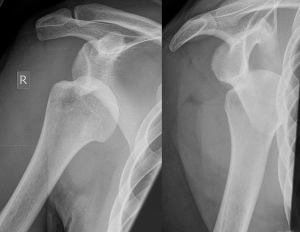What is shoulder dislocation?
The shoulder joint follows a ball and socket configuration, where the humeral head is centered within the glenoid fossa. Shoulder dislocation occurs when the humeral head is displaced from its normal position. Dislocation is considered partial when the humeral head is not entirely out of the glenoid fossa. A complete dislocation occurs when the humeral head is completely displaced from the socket.
What causes shoulder dislocation?
Dislocation occurs when an excessive external force displaces the humeral head from its position. This typically occurs following external trauma, such as from falls, or from the sudden movement of the arm, such as from throwing. Athletes in sports that require repeated strain of the shoulder are at greater risk for suffering this injury. Prior history of dislocation has been shown to be a significant risk factor for subsequent dislocation.
How is shoulder dislocation treated?
The arm is displaced in the direction of the dislocation of the shoulder. It is estimated that 95 percent of all dislocations are anterior (forward), and the arm typically looks out of place, and a visible deformity may be seen in the affected shoulder. Dislocation can be accompanied by other symptoms, such as pain, numbness, weakness, swelling, bruising, among others.
 The immediate treatment of acute dislocation is to immobilize the joint. The arm should be kept in a sling and held close to the torso. The placement of a pillow between the arm and the torso can provide both support and comfort. Ice packs should be placed as cold compress on the affected shoulder, and pain medications may be given to the patient while he or she is brought to the emergency room.
The immediate treatment of acute dislocation is to immobilize the joint. The arm should be kept in a sling and held close to the torso. The placement of a pillow between the arm and the torso can provide both support and comfort. Ice packs should be placed as cold compress on the affected shoulder, and pain medications may be given to the patient while he or she is brought to the emergency room.
The definitive treatment for shoulder dislocation is reduction, or manipulation to put the humeral head back in place. This is normally done through the external manipulation (closed reduction), and surgery will not be necessary except for the most severe of cases. There are numerous techniques for closed reduction. The physician may directly apply traction until the arm pops back in place, or the patient’s arm may be weighted. An initial X-ray is usually taken to document the displacement, and a confirmatory X-ray is often requested to confirm the successful reduction of the shoulder. Multiple attempts may be necessary; however, this procedure is successful in most cases.
The shoulder is immobilized after successful reduction. The arm is kept in a sling for several weeks. It is recommended that patients undergo physical therapy and rehabilitation to strengthen and condition the stabilizing muscles of the shoulder, particularly the rotator cuff. Recovery may take several weeks to months, depending on the severity of the injury. Patients who have frequent dislocations should be given medical advice on how to manage shoulder instability.
Some cases of shoulder dislocation are not responsive to closed reduction, and require surgery for open reduction. Surgery may also be indicated for patients with severely lax shoulder joints, and for patients whose shoulder joints are severely unstable. These patients will have a history of frequent shoulder dislocation, and this may already interfere with daily activities. However, this option should be discussed with a licensed specialist before any action is taken.



